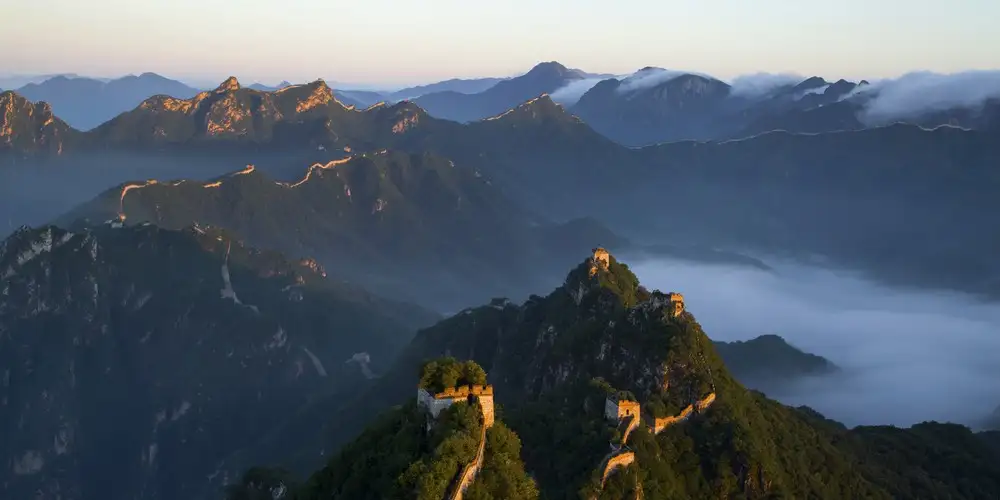
(Photo: Great Wall of China, Jiankou Section via Shutterstock)
Nobody ever mentions how steep the Great Wall of China is. You hear a lot about its age and its length, but the sheer vertical drop? Not so much. It doesn’t look all that intimidating from the pictures, either, flanked by red-gold foliage or dusted with snow, lazily weaving in and out of view along the rolling peaks of China’s northern frontier. When people talk about it, they usually throw around words like “majestic” and “awe-inspiring” and “impressive.” Somehow they always forget to say “steep.”
But for me, as I stare up from the base of a 4,000-step stairway at the outset of my six-day trek with active-travel outfitter G Adventures, “steep” is the first word that comes to mind. I’m barely out of the parking lot at the wall’s Mutianyu section—my hiking boots laced tight and a heavy daypack weighing me down—before I’m faced with that sky-high stairway. Which is when it hits me: Those 4,000 steps serve no other purpose than to deliver me to the lowest possible entry point for my six-day walk along the Great Wall.
There’s a gondola that could take me and the 13 other hikers in my group to one of Mutianyu’s 22 fortified square watchtowers, where many day-trippers begin and end their visits. But we came all this way to walk as much of the wall with our own two feet as we can, not to coast gently above it. So I take my first step and then my second, and then another and another until I eventually find myself in a pleasant, heart-pumping rhythm.
At first there’s not much to see. The stone steps are wide but heavily shaded by leafy trees, and I mostly just pass other travelers and wizened old buskers hawking Great Wall tchotchkes along the way to the main attraction. Then, maybe three-quarters of the way up, I come around a bend and catch my first glimpse of the wall up close.
It’s a monstrous thing, this ancient structure: rugged and relentless, snaking along the historical border between China and Mongolia like some massive mythical dragon made real from brick and stone. It clings to the high green peaks of the borderland at jaw-dropping angles, and it just goes on and on forever into the hazy distance. Steep? It’s about as vertical as you can imagine—in some places the well-worn steps rise 80 degrees skyward.
But in that moment when I first see the Great Wall up close, I understand why everyone forgets to mention its vertigo-inducing heights. In person, the sheer scale of it makes everything else an afterthought.
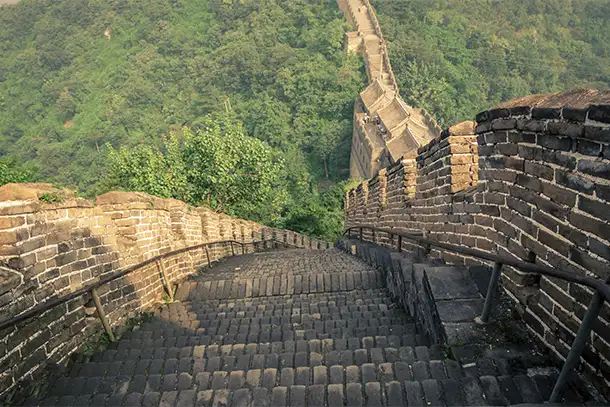 |
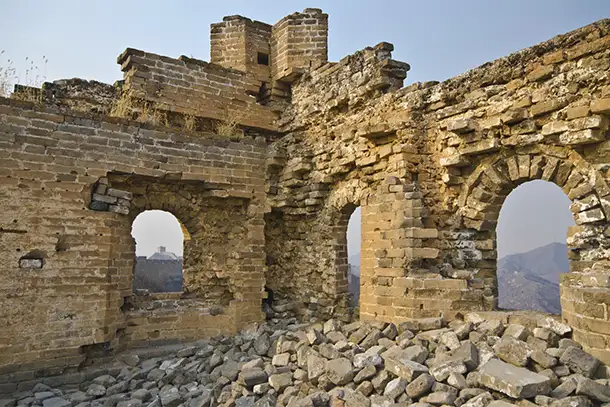 |
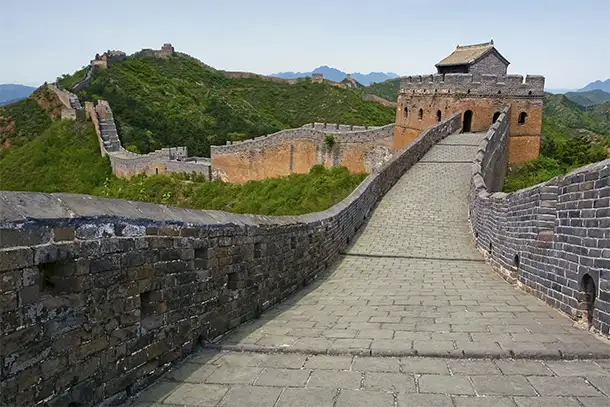 |
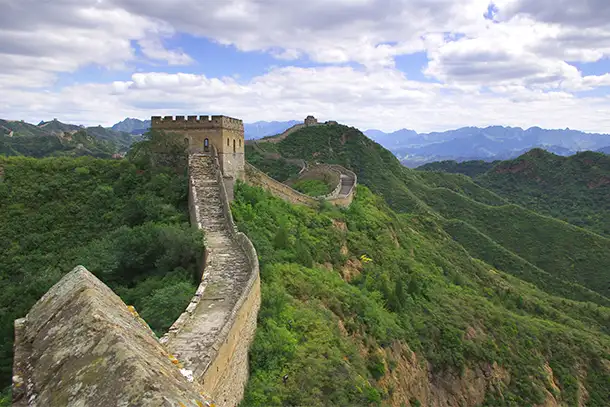 |
(Photos: Thinkstock/iStock)
Walking the Great Wall of China
My six-day trek with G Adventures makes a rough circuit around the parts of the wall near the former imperial capital and tombs, taking in the Mutianyu, Jiankou, Gubeikou, Jinshanling, and Huangyaguan sections, along with a brief exploration of Simatai, much of which is still closed for renovation.
Each area of the wall is a little bit different. Some are fully restored and teeming with tourists. Others are crumbling ruins swallowed whole by the forest, gloriously free of crowds and opportunistic vendors. I was drawn to this trek by the chance to explore parts of the Great Wall that many tourists never get to see, so not surprisingly I most enjoy the days when I can count the other travelers I meet on one hand.
On some days, we pass through fields of corn and cotton, where entire swaths of farmland are covered with makeshift scarecrows meant to fend off mountain chickens. Sometimes we walk on top of the wall for miles at a time, eye level with eagles; other times we walk in its shadow, glancing up now and then to remind ourselves that soon we’ll be back on it. We pass ruined farmhouses and dense patches of wildflowers and high mountain ridges where the wall and the forest have become one.
Most nights, our accommodations are simple guesthouses in villages where farmers have lived in the shadow of the wall for generations beyond memory. We never take any shortcuts to reach the trail—no gondolas or chairlifts when sturdy hiking boots will get the job done. Reaching the wall each day requires a strenuous climb, sometimes on stone steps like at Mutianyu, but more often on simple dirt paths carved out of the thick forest growth.
There aren’t any handrails or trinket sellers along the way on those days. Sometimes the closest we come to civilization is a warning sign informing us that the area is closed to the public. (Our G Adventures group has a special permit that allows us entry in these areas.) The hiking is different on the most broken-down sections of the wall. The terrain is rougher, the massive walls crumbling, and the whole structure appears ready to collapse in upon itself.
It’s these unrestored and uncrowded areas that offer up the Great Wall of China in all its raw beauty.
(Video: Josh Roberts / Great Wall of China at Jiankou)
What It’s Like to Travel with G Adventures
At $1,299 per person, G Adventures’ new-for-2014 “Walk the Great Wall of China” trip fits nicely into the “Bucket-List Trips You Can Actually Afford” category of adventure travel. The price includes accommodations, guides, ground transportation, admission fees, most meals, and a guaranteed departure. This is a small-group trip with an average size of 10 travelers and a maximum of 16.
There are 14 people in my group: three Americans (me included), two Aussies, two Germans, a Canadian, a Kiwi, and an Englishman, along with four Scottish women who are walking the wall to raise money for Alzheimer’s research. Living and walking in close proximity to each other for the better part of a week builds a bond. We develop a camaraderie that’s as much a part of the trip experience as the Great Wall itself.
It helps that G Adventures tends to attract like-minded travelers. None of us expects luxury hotels. Our accommodations are simple but clean, and our food is homemade and locally sourced, always tasty but never fancy. One night we receive a dumpling-cooking lesson from a local farmer. Another day, we practice tai chi at sunrise in a garden courtyard outside our bedroom doors. We’re just as likely to be awoken in the morning by a rooster or a dog as by the alarm clock. The day starts early in these remote villages. If our collective hope is to experience the Great Wall in a way that few other tourists ever do, we more than get our money’s worth.
G Adventures is essentially group travel for independent-minded travelers. Call it independent travel with a safety net. On the Great Wall, in a country where most of us don’t speak the language and where some areas are off-limits to tourists without a permit, it makes sense to travel with a local guide. In Beijing, where we spend a few days on either end of our six-day walk, our trip leader teaches us the skills necessary to get around: how to navigate the trains and buses, where to eat, what to see and do, and how to haggle with local vendors. G Adventures calls its trip leaders CEOs, or Chief Experience Officers. Ours is an endearing 24-year-old native of Xi’an who clearly loves introducing foreign travelers to her culture.
Beijing has become a very accessible city for Westerners since the 2008 Summer Olympic Games, and now most bus and subway routes are easily navigable for English speakers. Our days in Beijing before and after the wall are filled with organized group activities (a visit to Tiananmen Square and the Forbidden City, lunch with a local family, an afternoon rickshaw ride), optional activities (a Chinese-acrobats show, a kung fu performance), and free time that allows us to travel independently around the city.
If You Go
To take advantage of one of Air Canada‘s daily departures to China, I connected to the airline’s Toronto hub from my home airport in Boston. Air Canada has been voted “Best Airline in North America” four years in a row, and it’s my first choice for international flights whenever possible. A newly simplified process for handling checked bags in Toronto means that U.S. travelers no longer have to retrieve their luggage for customs inspection on connecting flights. And the international terminal at Toronto has another perk, too: hundreds of free-to-use iPads in the gate area.
It’s worth it to book a nonstop or direct flight to and from China. The flight is long—for me, about 15 hours in the air—and if you’re to have any chance of enjoying your first day in Beijing, you’ll need to arrive as rested as possible. Air Canada is a member of the Star Alliance, so save your miles and use them for an upgrade to business or first if you can. That also gets you access to the Maple Leaf Club Lounge in Toronto, which offers free food, showers, and Wi-Fi.
G Adventures will be running this trip once per month from April through October this year and next. Departures are guaranteed. You’ll need a valid passport plus a Chinese tourist visa, which can take about a month to get unless you expedite the process for an additional fee. If you live near D.C., New York, San Francisco, Los Angeles, Chicago, or Houston, you can apply for a visa in person at a Chinese consulate. Otherwise, you’ll need to use a visa service like China Visa Service Center. Budget about $75 on top of the $140 consular fee to pay for the visa service and mail delivery.
You don’t trek the Great Wall of China by accident—it requires too much effort to go on a lark. If experiencing this ancient wonder in a unique way appeals to you, commit to it before you go. That may mean weekend hikes or a few more hours on the treadmill than you’re used to. It’s worth it. When you’re staring up at those 4,000 steps on the first day of your journey, you’ll be glad you did.
What to Wear for the Great Wall of China
Other Articles by Josh Roberts:
- A Wild Kingdom in the Clouds: Inside Ecuador’s Mashpi Lodge
- Seeking Serenity on Scotland’s Northern Isles
- Iceland: Tolkien-esque Adventure in the Land of Fire and Ice
- 10 Best New Adventure Travel Trips of 2014
Have a question for Josh Roberts about his trip to the Great Wall of China? Want to share your own Great Wall experience? Leave a comment below! You can also follow Josh on Google+.
We hand-pick everything we recommend and select items through testing and reviews. Some products are sent to us free of charge with no incentive to offer a favorable review. We offer our unbiased opinions and do not accept compensation to review products. All items are in stock and prices are accurate at the time of publication. If you buy something through our links, we may earn a commission.
Related
Top Fares From Columbus, OH
Today's Top Travel Deals
Brought to you by ShermansTravel
Shop and Save with Country Inns...
Patricia Magaña
 Hotel & Lodging Deals
Hotel & Lodging Deals
$229 -- Chicago: Discounted Rates and...
Francesca Miele
 Hotel & Lodging Deals
$229+
Hotel & Lodging Deals
$229+
$188 -- Honolulu: Save on Oceanview...
Abigail Lamay
 Hotel & Lodging Deals
$188+
Hotel & Lodging Deals
$188+











































